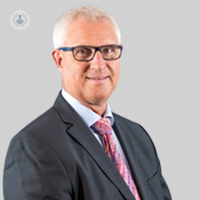The world's most painful condition? What is trigeminal neuralgia?
Written by:Trigeminal neuralgia is a chronic pain condition affecting the trigeminal nerve, which spans a large amount of the face and communicates signals of touch, and pain, to the brain. Trigeminal neuralgia is usually experienced as an extreme shooting, sharp pain, described by some as receiving an electric shock to the jaw or surrounding area. In his latest online article, renowned consultant neurosurgeon Mr Mathias Radatz offers his expert insight into this condition, explaining the cause, diagnosis and treatment.

What is trigeminal neuralgia pain like?
Searing pain, often felt in the lower part of the face, and usually only on one side, can suddenly hit the sufferer with no trigger whatsoever. However, some attacks can be brought on from mild stimulation in the face, for example simply through brushing teeth. It can be very difficult to describe, but it has been likened to everything from being hit with an ice pick, to stabbing, to burning.
As pain is often felt in the lower part of the face, especially in the jaw, some sufferers of trigeminal neuralgia visit the dentist, equating the pain they experience to tooth pain.
Trigeminal neuralgia is extremely rare, but for those who do suffer from it, it can be incredibly difficult to live with the pain. Attacks can come and go, sometimes occurring every few months or weeks, but as time progresses, attacks can become more frequent, and in extreme cases may occur hundreds of times in a single day.
What causes trigeminal neuralgia?
The function of the trigeminal nerve in those with the condition is disrupted, usually through pressure on the nerve which causes it to malfunction. This pressure is often caused by a blood vessel pressing on part of the nerve. Trigeminal neuralgia can be caused (but rarely) by other underlying conditions or injuries, such as a tumour, stroke, or facial trauma.
What makes trigeminal neuralgia worse?
There are often triggers that may provoke trigeminal neuralgia pain, such as:
- Smiling
- Talking
- Touching the face, for example to apply makeup
- Shaving
- Washing the face
- Brushing teeth
- Drinking and eating
As these activities are all part of daily life, it can be impossible to avoid them, and trigeminal neuralgia can have a great impact on the sufferer’s life, both through the pain and further health problems, such as a feeling of isolation, or even depression.
How is trigeminal neuralgia diagnosed?
Usually trigeminal neuralgia is diagnosed based on medical history, and the description of symptoms that the person gives. Physical and neurological examinations also help to diagnose the condition, and help to rule out other disorders that could also explain causes of facial pain. They will study the type of pain, the location in the face, and the triggers described, to get a true sense of the problem and possible causes.
Many conditions can cause facial pain, so it is important to find the definite cause in order to get the correct diagnosis and prescribe suitable treatment.
An MRI scan (magnetic resonance imaging) is often ordered, as it can rule out tumours, or multiple sclerosis as a cause of trigeminal neuralgia. These scans use strong radio waves to create images of the inside of the head, which can show great detail and give a clear picture for analysis.
What treatment can ease the pain of trigeminal neuralgia?
Most treatment starts with medication, which can block (or minimise) pain signals that are sent to the brain. These can be anticonvulsant drugs (often used in the treatment of epilepsy), or muscle-relaxing agents. In some cases, Botox has proven to be effective as a treatment, especially for patients who no longer respond to medication.
If medication is no longer working, surgery or other procedures may be beneficial. There are several different types of procedure available, so the specialist will discuss the best option for the patient, taking into account preference, physical health, and the areas of the trigeminal nerve affected.
With the right treatment plan, trigeminal neuralgia pain can be significantly improved. Visiting a pain specialist can help to put patients on the right track, with expert advice and a wide range of treatments often yielding life-changing results.
If you would like to book a consultation with Mr Matthias Radatz, you can do so today via his Top Doctors profile.


